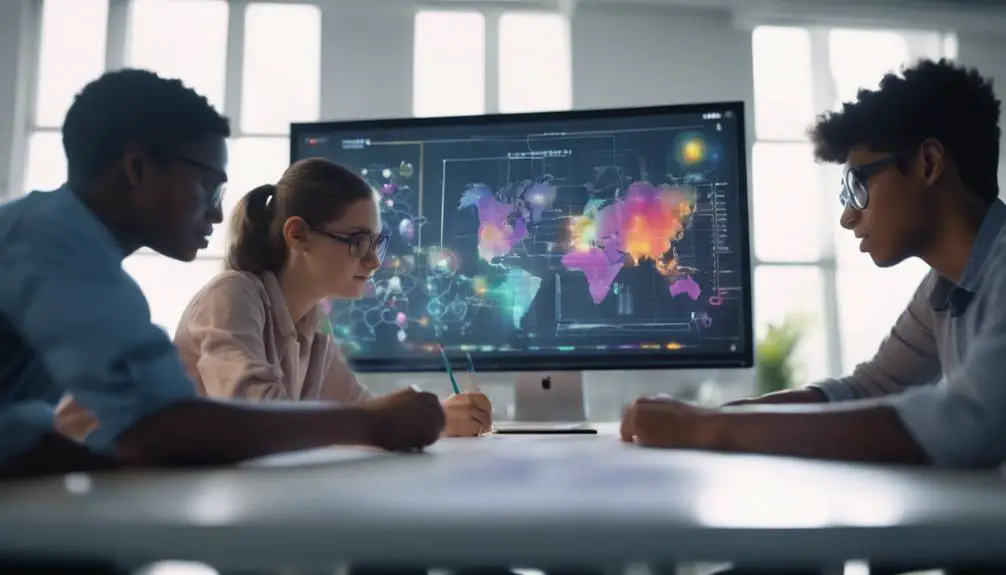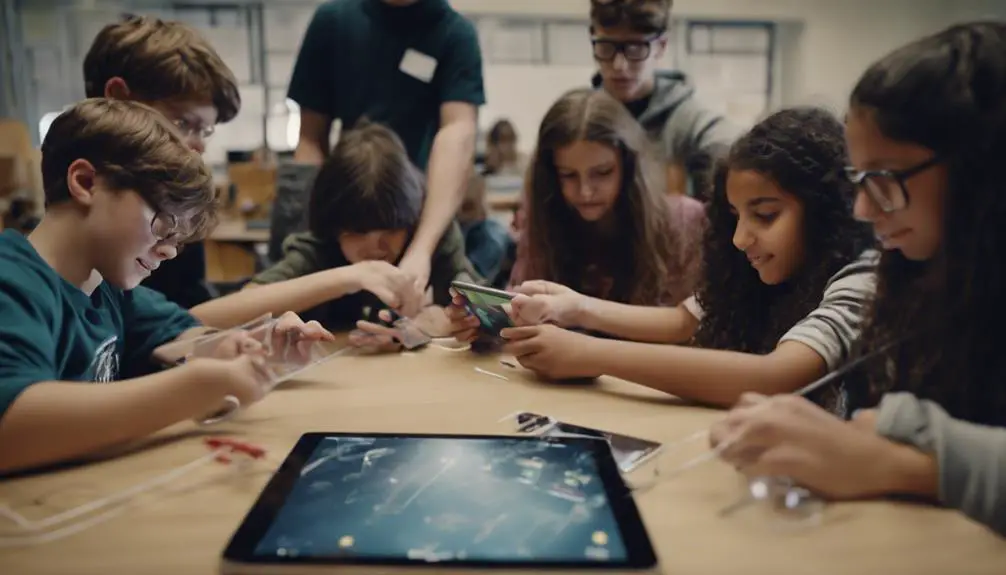In the classroom, interactive learning weaves a tapestry of engagement, enriching students’ knowledge and understanding. By incorporating activities like games, group projects, role play, debates, virtual field trips, brain breaks, reflection opportunities, and connection building, educators can truly enhance the learning experience.
These interactive strategies go beyond rote memorization to foster deep learning and develop lasting skills. Together, we can explore the myriad possibilities and see how these approaches can create a dynamic and engaging learning environment for students.
Interactive Learning Examples in the Classroom

When considering interactive learning examples in the classroom, it’s important to explore various approaches that can effectively engage students. Utilizing play as a learning tool can help simplify complex concepts and make them more enjoyable for students.
Group projects, role-playing, debates, and peer teaching are all effective methods to boost student participation and comprehension. These interactive techniques foster a dynamic and engaging learning environment, encouraging students to actively participate and deepen their understanding of the material.
Learning through Play
Engaging students with interactive games creates a lively learning environment that helps them grasp and remember essential concepts. Fun activities not only capture students’ interest but also encourage them to actively participate. Through interactive games, students can put their theoretical knowledge into practice, leading to a deeper understanding of the subject.
These games allow students to explore ideas in a hands-on way, making learning more enjoyable and memorable. By integrating interactive games into the curriculum, educators can cultivate curiosity and critical thinking skills. Ultimately, student involvement in interactive games enhances comprehension as they play an active role in their learning, making education more enjoyable and effective.
Group Projects
Exploring group projects in the classroom helps students develop collaboration, communication, and problem-solving skills. Working together towards a shared objective, students learn to utilize their strengths and support each other’s growth.
Diverse perspectives come together to creatively tackle challenges, enhancing problem-solving abilities. Effective communication is practiced through active listening, idea sharing and providing constructive feedback.
Students engage in creative collaboration by brainstorming, planning, and executing projects, fostering compromise and innovation. These interactive projects not only deepen understanding but also equip students with valuable life skills for their future endeavors.
Role Play
Participating in role-play scenarios helps students better understand and empathize with others in a hands-on classroom environment. Through empathy exercises and acting out different situations, students can explore diverse perspectives, which deepens their comprehension and emotional intelligence.
Interactive simulations provide realistic experiences that aid in developing empathy by immersing students in a variety of scenarios. By taking on different roles, students not only improve their understanding but also cultivate a stronger sense of empathy towards others.
Role-playing is a powerful tool for exploring different scenarios, allowing students to gain insights and a deeper understanding by stepping into someone else’s shoes. Ultimately, role play is an effective way to promote empathy and enhance understanding in educational settings.
Debates
Shifting from role-play scenarios to structured debates, students face the challenge of engaging in structured arguments on various topics, which helps in honing critical thinking skills in an interactive classroom environment.
Structured debates prompt students to assess arguments logically, construct and deliver persuasive arguments, and participate actively in dialogues with their peers. These thought-provoking discussions encourage individuals to present and defend their viewpoints while also learning to actively listen to opposing perspectives.
Participation in debates equips students with the ability to think critically, communicate effectively, and consider diverse viewpoints, fostering not only academic skills but also essential life skills like communication and respectful discourse.
Peer Teaching
Interactive learning in the classroom can be enhanced through peer teaching, where students take turns teaching each other. This method not only helps students reinforce their own understanding but also creates a supportive learning environment. When implementing peer teaching, it’s important to consider the following aspects:
- Peer Feedback: Encourage students to give constructive feedback to their peers to support growth and improvement.
- Teaching Strategies: Explore different teaching methods to accommodate various learning styles in the classroom.
- Student Collaboration: Emphasize the value of teamwork and collaboration, allowing students to learn from each other’s strengths and perspectives.
Think-Pair-Share
To promote active learning in the classroom, the Think-Pair-Share strategy encourages students to think on their own, discuss with a partner, and then share with the class. This approach helps develop critical thinking skills and encourages participation.
During the thinking phase, students brainstorm ideas independently to deepen their understanding. When they collaborate with a partner, they engage in discussions that allow for the exchange of diverse perspectives, improving overall comprehension.
Lastly, sharing with the class enables students to learn from each other and gain empathy by considering different viewpoints. By fostering meaningful interactions, this method creates a dynamic learning environment that emphasizes collaboration and deeper learning.
Kinesthetic Approach
Incorporating movement and physical activities into learning helps cater to different learning styles and boosts student engagement in the classroom. By encouraging students to act out historical events or scientific processes, they can better internalize information.
Activities like dance or role-playing keep students actively involved in the learning process, enhancing their understanding. Providing hands-on materials for manipulation during lessons also fosters a deeper comprehension of complex concepts.
Grab Bags
Introducing surprise learning items in bags creates a sense of excitement and curiosity, enhancing interactive learning experiences in the classroom.
The surprises hidden within a Bag of wonders invite exploration and foster anticipation for learning. It’s a joy to see students’ eyes light up as they reach into the bag, eager to discover what’s inside.
This interactive engagement creates a dynamic and memorable learning environment. By incorporating grab bags into my lessons, I make learning enjoyable and encourage active participation and critical thinking.
The element of surprise keeps students engaged, promoting a sense of wonder and discovery that enriches their overall learning journey.
Charades
Playing charades with students is a fun way to encourage active participation and boost classroom interaction. It helps students improve their acting skills by conveying ideas and emotions through gestures and facial expressions. Additionally, charades promote critical thinking and vocabulary recall as students work together to guess the words or phrases acted out. By focusing on nonverbal communication, students also enhance their understanding of body language and visual cues for effective message delivery.
Moreover, charades foster teamwork dynamics by encouraging collaboration and shared problem-solving among students. It provides a platform for creative expression as students explore different ways to represent the given clues. This game not only entertains but also enriches the learning experience by combining fun and educational elements seamlessly.
Four Corners
I facilitate a classroom activity called Four Corners where students choose different corners of the room to represent various viewpoints on a given topic. This interactive game encourages students to physically embody different perspectives, promoting engagement and lively discussions.
By actively participating in selecting viewpoints, students engage in debates and collaborative learning experiences. The Four Corners game enhances classroom interaction and fosters critical thinking, empathy, and understanding of diverse opinions.
Through defending their chosen corners with enthusiasm, students contribute to respectful exchanges of ideas and build a sense of community within the classroom.
Pictionary
Pictionary is a fun drawing game that helps students guess words through pictures. It boosts communication skills, creativity, teamwork, and engagement. Let’s explore three key benefits of using Pictionary in the classroom:
- Improved Communication: Pictionary prompts students to communicate visually, enhancing their ability to convey ideas effectively.
- Creative Expression: Students can unleash their creativity by drawing, and expressing concepts in imaginative ways.
- Teamwork Development: Working in teams to guess and draw words teaches students the value of collaboration and supporting each other toward a common goal.
Memory Game
Using a memory game in the classroom can greatly improve students’ focus, memory retention, and cognitive skills. These games include concentration exercises and memory challenges that offer an interactive way for learners to enhance their cognitive abilities.
The matching tasks in memory games are excellent tools for boosting cognitive skills, helping with brain training, and memory enhancement. Participating in concentration games not only makes learning enjoyable but also aids in cognitive development.
Educational Scavenger Hunt
Moving away from memory games, a new approach to enhancing cognitive skills in the classroom is by introducing an Educational Scavenger Hunt. This activity immerses students in a playful quest for information, making learning interactive and fun. When organizing this game, the focus is on creating an environment that excites students about learning. Here are some essential elements of an Educational Scavenger Hunt:
- Classroom Exploration: Students are encouraged to move around different areas of the classroom to discover clues or answers.
- Learning Adventure: Traditional lessons are transformed into exciting journeys where students actively engage in seeking knowledge.
- Knowledge Quest: The search for information becomes a quest that ignites curiosity and enhances critical thinking skills.
Virtual Field Trip
Virtual field trips transform classroom learning by using technology to immerse students in new environments. Through virtual exploration and interactive technology, students can embark on digital adventures and engage in hands-on learning experiences.
These remote discovery opportunities offer students virtual experiences that transport them to different locations and introduce them to a variety of concepts. Technology tours provide educational journeys that spark curiosity and deepen understanding.
Brain Breaks
Incorporating short, refreshing activities known as brain breaks can help students stay focused, boost their mood, and increase engagement levels during learning sessions.
Including activities like energy boosters, mindful breaks, focus refreshers, quick games, engagement enhancers, mood lifters, and fun breaks can have a positive impact.
For instance, you can try guided breathing exercises, stretching routines, games like Simon Says, quick dance sessions, or group activities like charades.
Reflection Opportunities
Taking time for reflection is key in helping students truly grasp and articulate their understanding of the material. Various methods like reflective journaling, group discussions, silent contemplation, and sharing in class provide avenues for students to ponder individually and gain insights from peers.
Personal and group reflections enable students to link their thoughts with others, strengthening their critical thinking abilities. Quiet introspection and collaborative reflections create a space for students to solidify their learning and gain fresh perspectives.
Through structured reflection time, educators empower students to engage with the content more deeply, leading to a more meaningful and comprehensive learning journey.
Connection Building
Creating a sense of community and belonging in the classroom is crucial through interactive learning experiences. To enhance community building and belonging in interactive tasks, focus on these key strategies:
- Promote Collaboration: Engage students in group projects or discussions that require teamwork to achieve shared goals, fostering a strong sense of community.
- Use Icebreaker Activities: Begin each class with interactive icebreakers to help students feel at ease and involved from the start, promoting a sense of belonging through initial interactions.
- Encourage Feedback and Reflection: Incorporate interactive tasks that prompt students to share feedback and reflect on their experiences, creating opportunities for connection and a deeper sense of community.
Conclusion
Interactive learning in the classroom brings a refreshing approach, infusing energy and excitement into the educational journey. It acts as a catalyst, sparking curiosity and active engagement among students, transforming them from passive listeners to enthusiastic participants.
Embracing interactive learning examples creates a vibrant and dynamic learning environment where students can thrive and excel. It turns learning into a joyful voyage of discovery, where every moment presents an opportunity for growth and knowledge expansion.











